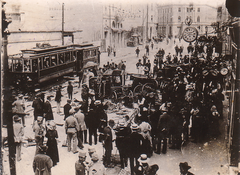 A crowd gathered around piles of destroyed Serb property in Sarajevo, 29 June 1914 | |
| Date | 28–29 June 1914 |
|---|---|
| Location | Sarajevo, Bosnia and Herzegovina, Austria-Hungary |
| Cause | Anti-Serb sentiment in the aftermath of the assassination of Archduke Franz Ferdinand |
| Participants | Bosnian Muslim and Croat population in Sarajevo, encouraged by the Austrian authorities |
| Deaths | 2 Serbs killed |
| Property damage | Numerous houses and buildings owned by Serbs |
| Inquiries | More than 100 Serbs arrested on suspicions of supporting the assassins of Franz Ferdinand[1] 58 non-Serbs arrested[2] |
The anti-Serb riots in Sarajevo consisted of large-scale anti-Serb violence in Sarajevo on 28 and 29 June 1914 after the assassination of Archduke Franz Ferdinand. Encouraged by the Austro-Hungarian government, the violent demonstrations assumed the characteristics of a pogrom, which led to ethnic divisions that were unprecedented in the city's history. Two Serbs were killed on the first day of the demonstrations, and many others were attacked. Numerous houses, shops and institutions owned by Serbs were razed or pillaged.
- ^ Donia 2006, p. 127
- ^ Donia 2006, p. 128